
Extrication Tips: October 2014
Randy Schmitz
Features Extrication TrainingAs driver comfort and safety become more important to car buyers, it’s crucial for rescuers to understand the myriad occupant-safety devices in today’s vehicles.
As driver comfort and safety become more important to car buyers, it’s crucial for rescuers to understand the myriad occupant-safety devices in today’s vehicles.
Rescuers need to stay current with vehicle technology and be aware of any hidden hazards and dangers such as inadvertent airbag deployment. Although rescuer-induced, post-crash airbag deployment is rare, there have been two documented cases in which rescuers have been injured from airbag deployments and one documented close call. All three incidents took place while the 12-volt electrical system was still intact, and the vehicles were severely damaged.
The seatbelt is the most significant safety feature designed in the last 40 years to protect vehicle occupants from harm; airbags are a close second. Most new-model vehicles are made with driver and passenger frontal airbags, side-impact airbags in the seats, and roof-curtain airbags. Six airbags are standard in typical vehicles. Many higher-end vehicles have knee bags and rear-seat side-impact airbags as well; eight or 10 airbags are becoming more common.
Pedestrian protection
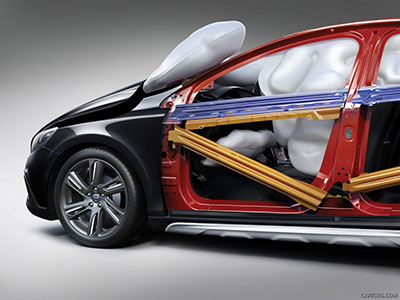 |
|
| Photo 1: The new Volvo V40 includes a pedestrian airbag that deploys when sensors in the front bumper detect a human leg bone. Photo courtesy of Volvo
|
Luxury vehicles such as Mercedes, Volvo and Jaguar have cutting-edge safety technology. Volvo, along with a few other car manufactures, is attempting to address the global increase in pedestrian fatalities. Head and neck injuries are the most-common in pedestrian incidents; these injuries are caused when the pedestrian’s head hits the windshield and A-pillars after he or she has been struck by the vehicle at the lower extremities.
In the new Volvo V40, seven sensors inside the front-bumper area send a signal to the vehicle’s electronic control unit (ECU), which detects a human leg bone and differentiates it from another vehicle’s front end; when this type of signal is received, the outer airbag is deployed (see photo 1). Pyrotechnic devices then trigger the release of the hood’s hinges and raise the back of the hood up about 10 centimeters to create a cushioning effect for the pedestrian’s body. This increases the space between the hood and the firewall and helps to reduce the impact when the pedestrian hits the hood. The speed of the vehicle must be between 20 kilometres per hour (kph) and 50 kph for the system to be in effect.
Seatbelt systems
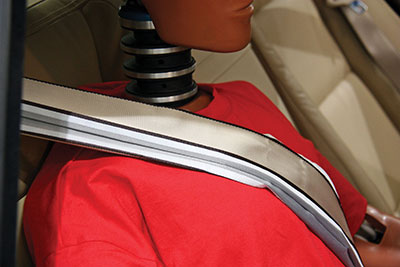 |
|
| Photo 2: The Mercedes Benz belt bag includes Velcro edges for seamless deployment. Photo courtesy of Mercedes Benz
|
Ford Motor Company has broadly released an interesting advancement in seatbelt design and safety called the inflatable seatbelt, which was originally launched on the 2011 Ford Explorer. This ground-breaking, injury-reducing technology lowers the energy impact during a collision on smaller occupants seated in the vehicle’s rear, where there are no secondary-restraint devices such as airbags. The design phase of the inflatable seatbelt took the better part of 10 years, but the result has proven to be extremely successful. The concept is simple: during a frontal or side-impact crash, the belt inflates to create a cushion between the belt itself and the occupant’s chest; the system spreads out the forces exerted by traditional seatbelts. The system is similar to a tubular, miniature airbag; upon deployment, it uses cold, high-pressure gas stored in a small cylinder near the bottom of the seatback to inflate the belt when crash sensors determine the need for additional protection. The deployment time to full inflation is about 40 milliseconds and the airbag stays inflated for several seconds before it starts to release the inflating product through specialized pores built into its fabric. Ford plans to offer this technology in all its vehicles over the next several years.
Mercedes Benz is about to release its own version of the inflatable seatbelt called the belt bag in its S-class sedan (see photo 2). The system consists of an accordion-style airbag fitted inside the seatbelt, but with Velcro edges that allow for seamless deployment; this, accompanied with belt-force tensioners and limiters built into the rear-seat system, give greater protection for those seated in the back of the vehicle.
Airbag advancements
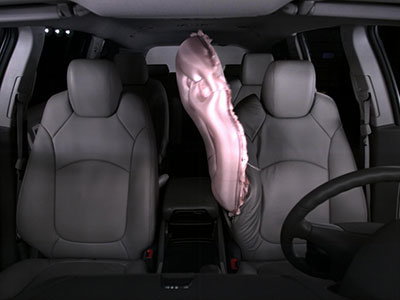 |
|
| Photo 3: GMC’s centre airbag is designed to prevent occupants from colliding during a side-impact crash. Photo courtesy of General Motors Company
|
An industry-first, General Motors Company (GM) has developed a method to reduce occupant collisions inside a vehicle during side-impact crashes. Named the front-centre airbag, this system is active in the new 2015 GMC Yukon and three of GM’s top sellers: the Buick Enclave, GMC Acadia and Chevy Transverse (see photo 3). So far, the airbag system is available for front-row passengers only. The system looks similar to a standard, side-impact airbag when deployed, however, it is attached to the inner side of the driver’s seatback and is designed to act as an energy-absorbing protective barrier between two occupants to prevent them from colliding into each other during a side-impact crash. The airbag is shaped like a figure eight and wraps around the driver slightly with a thicker top for increased head protection; the airbag stays inflated for roughly five seconds after deployment. In addition, the system provides extra protection in a rollover situation. One of the biggest risk factors in side-impact collisions is when occupants’ heads slam together as a result of being violently thrown into each other. Now, in conjunction with the inflatable roof-curtain airbags, the passengers are protected from both sides in a side-impact situation. According to the National Highway Traffic Safety Administration, nearly 29 per cent of fatalities of belted front occupants in side-impact, non-rollover crashes are caused by these incidents. Advancements such as these are certainly capable of lowering these statistics.
Mercedes Benz is taking a serious approach to the same occupant-fatality issues. Its injury-reducing technology is called interseat protection. Similar to the GM centre-seat airbag, within fractions of a second a lattice-like inflatable structure pops out from the edge of the seatback to create a separation between the occupants.
The Toyota Scion iQ rear-window curtain airbag is designed to inflate during a rear-end crash and protect the rear-seat occupants’ heads. This interesting addition to Toyota’s Scion fleet first debuted in 2012 and is quite impressive. The curtain-style airbag deploys from the roof lining just above the rear-window frame; it then envelops the rear headrests to provide increased head protection.
Toyota’s Yaris and iQ, and Subaru and Renault all have airbags on the front driver and passenger lower seat cushions; these airbags deploy during a frontal collision to keep occupants from slipping out from underneath the seatbelt. When a vehicle occupant slides out from under the seatbelt, a submarining effect can occur, during which the unrestrained driver or passenger hits the dash, steering wheel or the frontal airbags. Types of injuries depend on how the person is seated and whether or not the seatbelt is worn properly or tightened enough to offer protection. When the seat-cushion airbag deploys, it forces the front part of the lower seat cushion upward, which places the occupant’s pelvis in a position to keep him or her from slipping forward.
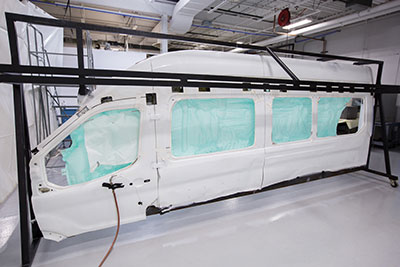 |
|
| Photo 4: Ford Motor Company, in collaboration with TRW Automotive, is set to release its largest airbag yet called the side-impact curtain. Photo courtesy of Ford Motor Company
|
Ford is set to release its largest airbag yet, the side-impact curtain, in collaboration with airbag manufacture TRW Automotive (see photo 4). In 2015, Ford will include this jumbo airbag in its 15-passenger transit wagon. This side-impact curtain measures 4.5-meters long by one-meter high to encompass all five rows in one deployment. The system is part of Ford’s safety canopy technology and has been in the works for the last four years. This airbag is the largest in any vehicle to date; it specializes in minimizing injuries to the head, neck and torso during side-impact crashes and rollovers. Large passenger vans are susceptible to rollover. Once the crash sensors detect an impact or rollover, two large inflators release 120 litres of compressed gas into the bag in a fraction of a second.
Ford has added an interesting change to its 2015 Mustang. Until now, Ford housed a knee bag inside the traditional glove box. When the knee bag deploys in a frontal crash, the whole front section of the glove box – with the airbag attached to it – deploys to protect the passenger’s lower limbs from hitting the dash. Now, moving away from traditional fabric material used by most manufactures, Ford has come up with a flexible, plastic, bladder-type inflation unit that is attached to the door of the glove box. Upon deployment, a gas inflator fills the bladder, moving the glove-box door forward; this change offers greater protection for the knees as the knee bag covers a larger area. Rescuers should expect to see this new knee bag as standard equipment in the Mustang, along with the eight other airbags within the vehicle.
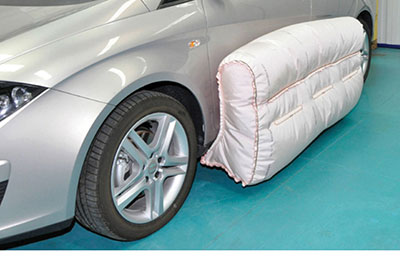 |
|
| Photo 5: TRW is developing an airbag that deploys on the outside of the vehicle. Photo courtesy of TRW Automotive
|
External airbags have not yet surfaced, but some airbag-manufacturing companies such as TRW are working on technology that deploys an airbag on the outside of the vehicle rather than the inside (see photo 5). The airbag deploys from the lower rocker-panel area during a side-impact crash and can inflate within 20 to 30 milliseconds; this creates a barrier between the driver and passenger of a vehicle that is being hit on the side from another vehicle. According to a TRW spokesperson, “the 200-litre bag – which measures 15 to 20 centimetres (cm) deep, 70 cm high and 200 cm long – rotates upwards when deployed, shielding both the front and rear doors up to the belt line. To ensure a rapid deployment in 20 to 30 milliseconds, two inflators are used. TRW has patented a unique inner structure to make the bag stiffer, while the bag’s pressure depends on the manufacturer’s strategy.”
Another attempt to increase safety is an experimental project from Mercedes Benz called the braking bag. The idea behind the bag is to slow down a vehicle prior to a collision to reduce impact force; this is considered a pre-crash initiative in which sensors determine distance and imminent-crash forces from the involved vehicles. Think of this as an additional braking system. An airbag placed near the front axles and undercarriage is deployed in a pre-crash situation to slow down the vehicle, similar to an emergency-braking system. This means the rate of deceleration is improved by more than 20 milliseconds, which reduces collision severity. The moment the bag deploys it raises the front end of the vehicle up about eight centimeters, which improves crash-force compatibility with the other vehicle by minimizing the nose-diving effect to better allow restraint systems to perform at optimum levels.
Today’s vehicles are designed for greater passenger safety but, due to the degree of vehicle diversification, this information can only serve as a guideline for rescuer safety. The array of designs and features in today’s cars makes it very difficult for rescuers to become familiar with all the potentially hazardous components. Vehicle restraint-system familiarization can only emphasize safety to address the hazards. Responsibility for overall efficiency and the safety of those involved ultimately rests with the officers and crew members attending the scene.
Randy Schmitz is a Calgary firefighter who has been extensively involved in the extrication field for 21 years. He is an extrication instructor and has competed internationally. He is the education chair for Transport Emergency Rescue Committee (T.E.R.C.) in Canada, a T.E.R.C. & WRO International extrication judge and a tester and evaluator for manufactured prototype products for extrication equipment. He can be reached at rwschmitz@shaw.ca. Follow him on Twitter at @firedog7
Print this page